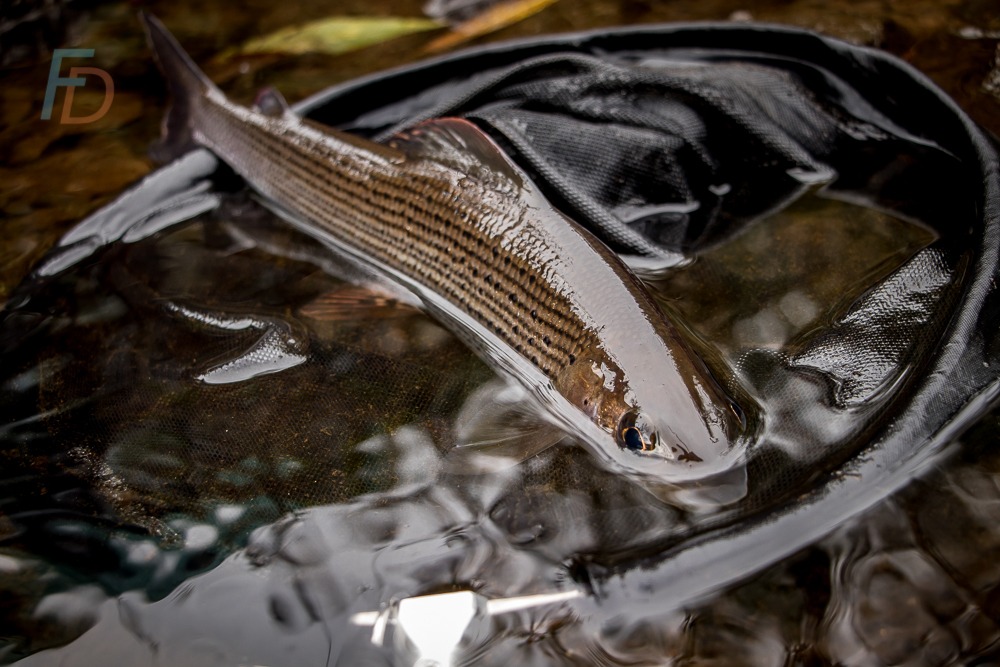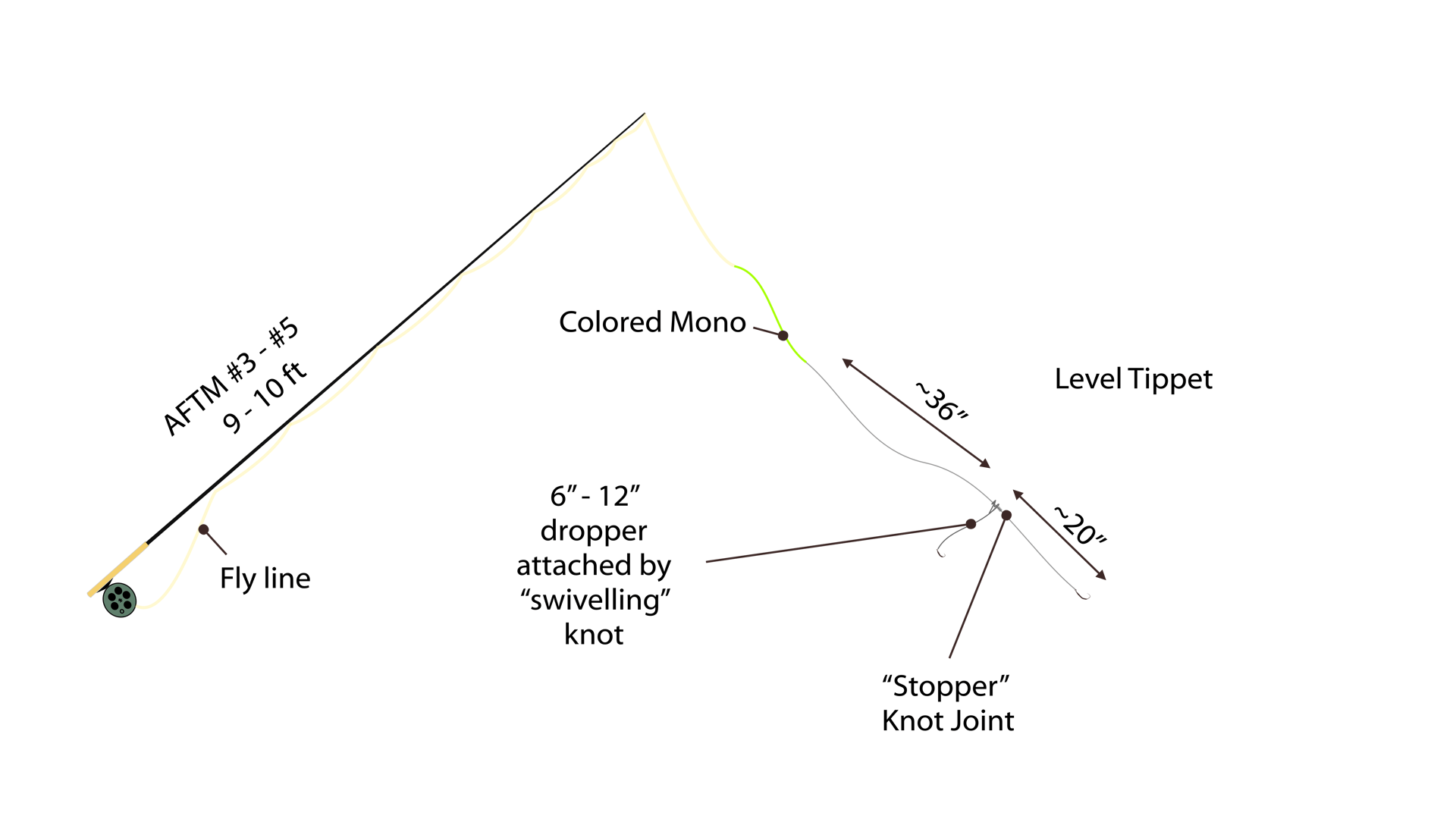What is Polish Nymphing?
Polish Nymphing is a short-line method of presenting weighted nymphs to catch grayling and trout. It was made famous in 1989 by Wladyslaw ("Vladi") Trzebunia when he won the World Fly Fishing Championships in Kuusamo, Finland. It is one of the family of Euro nymphing techniques.
However, it was in 1984 on the Dunajec River in Poland that Jozef Jelenski showed Czech competitors some basic flies (and the teams saw the simple, short-line tactics used by Polish team members) that began the spread and development of both Czech and Polish Nymphing tactics.
A great rivalry between the teams of those two nations certainly pushed developments in nymphing forward by huge leaps in the decades between the 1980s and the early 2000s.
This article covers:
Polish Nymphing Mistake #1: Don't Call it Czech Nymphing
You know that line in Star Wars "A lot of people died to bring you these plans"? Well, a lot of blood, sweat and tears went into refining short line competition nymphing techniques. So calling ALL short-line nymphing "Czech Nymphing" when speaking to a proud Polish competitor might just earn you a punch on the nose.
That being said, it probably takes a real expert to identify the different schools of short-line nymphing at a glance. Because both Polish and Czech nymphing tactics evolved and cross-pollinated continuously all through their development, it is a tricky challenge to tease them apart afterwards.

Beautiful woven nymph tied by Vladi Trzebunia in 2000 (gifted to Stuart Crofts at World Championships)
While the Polish team won the World Championships in 1985 - short-line tactics were used by Czechia's Slavoj Svoboda to win gold in Belgium in the 1986 World Championships. So began a hard-fought rivalry between these two exceptional river fly fishing nations.
In 1989, Vladi Trzebunia's individual total fish captures - famously - was more than that of the entire second placed TEAM...It was also more than the second, third and fourth placed teams' COMBINED TOTAL.
That result, possibly more than any other single event, changed the landscape of river nymphing forever. The ironic thing is, the Czech team's response was to absorb those tactics and use them as a strong component of their future successes (including the famous thrashing of the home nations on the Welsh Dee in 1990).
That story - as well as ultra-detailed instructions on the Czech Short-lining techniques - features in our free email tutorials:
Being absolutely truthful, with all the developments made in both Poland and Czechia - it's probably impossible to separate a "pure-breed" of Czech and Polish nymphing tactics. The best we can do is point out one or two features that are "a bit more associated" with early Polish nymphing...
Mistake #2: Not All Polish Nymphs are Woven
Yes, the Polish Woven Nymph is a thing - and the famous Vladi was a creator of beautiful examples - including the one pictured above. But, woven nymphs are certainly not the only game in town. When the Polish and British medical systems held a skills exchange project in the mid to late 1990's, Dr Jurek Kowalski brought his fishing gear with him to Yorkshire, England.
Dr Kowalski, it turns out, was a mad-keen angler and he had researched and arranged, by letter, to meet up and fish with England team member, Stuart Crofts. When Stuart asked to see Jurek's woven nymphs, he smiled and said:

Dr Jurek Kowalski
Polish Nymphing Expert and Medic
"We usually save those to sell to the tourists!"
Instead, Jurek (who also featured in Tom Fort's fishing travel book: "Against the Flow: Wading Through Eastern Europe") showed Stuart his simple system of FISHING flies. He fished just one pattern - with two color variations. Both had a brown wool body and then either a yellow or a pink wool head. Here is one tied by Jurek himself:

Lead wire underbody, wool body and head, nylon monofilament rib - a Jurek Kowalski Polish Nymph
This basic fly design is part of Jurek's brutally stripped down, practical system. To create different weights of fly, he just has different size hooks and a single layer of lead wire, wrapped on in touching turns. His reason is that "You can get more wraps on a bigger hook". By using the same gauge wire for all flies, the weight is directly proportional to the number of turns of that wire on the hook.
Stuart took Jurek fishing on Yorkshire's River Ure - and began to apologise when they arrived. The recent rainfall had brought the river up to a worrying height. This was in the days before online (or phone hotline) river-level gauges and the Ure was an hour or two's drive from where Dr Kowalski was staying.
Jurek looked at Stuart with a puzzled expression - "It looks fine to me?".
Polish Nymphing Tactics in a Swollen River Ure
Sure enough, using Polish shortlining tactics that Stuart had never seen before, Dr Kowalski proceeded to catch grayling after grayling from the swollen river.

After a while, he beckoned the (rather stunned) host over to him and encouraged Stuart to try. Although, initially, many flies were lost on rocks ("This is why we don't fish with woven nymphs Stuart!") - Jurek demonstrated how to guide the nymphs up and over obstacles.
Soon Stuart was catching fish hand over fist - and from parts of the river he had never caught grayling from before.
Polish Nymphing Flies: Two Flies with a Story to Tell
I am told that one of the England team members (various names excluded to save blushes) when returning from the World Championships in 2000 had some serious questions to answer from his wife. Apparently she had a hard time believing that the multiple packets of condoms brought home in his luggage were for "fly tying"...
Strangely - it was true and down to that man Vladi again...
He had invented a crazily realistic earthworm pattern that used the stretched, thin latex from a condom over a lead wire and coloured tying thread to create a lifelike, segmented body. The "Vladi's Worm" was born. Of course, the England team wasted no time buying up stacks of the necessary raw materials from the vending machines in the Czech bars!
Here is one, tied from a genuine Czech condom to Vladi's Polish pattern from the 2000 championships (you can see that the latex hasn't lasted too well over the past couple of decades!)

20 year-old Vladi's worm with the latex condom beginning to perish (let that be a warning to you!)
The next pattern with a story is another super-simple fly. This time it has been tied by Dr Stanislaw Cios - a brilliant fish and invertebrate biologist AND Polish Diplomat. The story behind this one I probably need to tell in a book rather than a blog post, but it stems from Dr Cios travelling the world with his job and having to stay in a lot of hotel rooms...

Dr Cios' "Hotel-Room" Polish Nymph
It's safe to say that this pattern also answers to the description of a simple but effective fly which is quick to tie and not so painful if you happen to lose it.
Mistake #3: Using 3 Flies in Poland
For Czech nymphing it is very common to use up to three flies on your tippet. If you try that trick in Poland you'll find yourself with some tricky questions to answer from the fishing co-operative rangers. A maximum of two flies are allowed on your leader in Polish rivers. That rule means nymph anglers from Poland often like to continue using their familiar two-fly setups when they travel to other countries.
OK, so much for what NOT to do. How about learning some Polish tactics to add to your nymphing playbook ?
Rigging up for Polish Nymphing: Proportions and "no tangle" Droppers
So, it will be obvious that your tippet should carry two (rather than three) nymphs. Vladi's proportions are to tie a level (single diameter) section of tippet about the same length as nose to tip of his finger to the end of his coloured nylon "indicator tippet". For most people that's roughly 3ft. Then a section 20 inches long is tied to that (for example by blood-knotting the two sections together).

Outside of competitions (where the dropper must be fixed in place), that knotted joint acts as a "stopper" for a special knot formed from a loop which will slide up and down the line. This sliding knot must be on the opposite side of the stopper knot to your point (end) fly - which is attached to the 20" tail end of tippet. I'm currently researching the fine details of Vladi's swivel knot - but the mechanics are similar to our "Ladder Leader" (with important differences too). Both systems also have similarities to the super oldschool horsehair leaders and droppers used in both North Country wet fly and H.C. Cutcliffe's Devonshire wet fly fishing in the 19th century.
For more details and hist knot diagrams, my book explaining Cutcliffe's Fishing methods, life and the book he wrote is available on Amazon (where purchases obviously earn me some royalties - thank you).
For deep water, Vladi liked a long dropper (as much as ten or twelve inches in length), while shallow water would see him using a shorter dropper to avoid snagging.
Now let's look at fundamental tactics.
Vladi's Presentation Tactics
One key part of Vladi's approach to Polish nymphing was the observation that his father made while bait-fishing in the 1930s.
He found that more fish were attracted to his bait when it was pulled downstream fractionally faster than the true pace of the current. This is another version of the "induced take" where the impression of escaping prey triggers a predator to strike.
Think about cats playing with string - the yarn isn't very interesting when it just lies still. When it is drawn away to "escape", that's when the cat pounces...
This principle turned out to work just as well with artificial nymphs as it did with bait. An important factor here is that it KEEPS THE FLIES DEEP. This is the total opposite of many other "induced take" tactics - where the nymphs are swept upwards towards the surface.
So the sequence is pitch the nymphs up and slightly across the stream, ACTIVELY LEAD the flies just fractionally faster than the current (which also creates amazing strike indication). At the end of the drift you have two choices:
- As the flies begin to pass downstream of the angler, raise the rod and flies slightly and STOP tracking the drift. This allows the flies to swing under the line (under tension) and then be raised up right to the surface in a classic upwards "induced take". The Drift is finished with a mandatory hook-set (even if no indication of a strike was seen or felt).
- Instead of allowing the flies to pass under and sweep up - just perform the mandatory hook-set before the flies overtake the line
Here is Vladi in action (captured on Jack Dennis' DVD - which you can still buy on ebay I believe - and shown on Jack's YouTube Channel)
Right - that's all I have for now in this article; look out for the extended stories on Stanislaw's "Hotel nymphs" as well as the fully-researched information on Vladi's dropper knots and more in upcoming nymphing book and video content.
In the meantime - make sure you benefit from all the nymphing tuition and special offers in our Year+ of Free Email Tuition:
As ever, your comments are requested so that you can help shape this and all future content on the site - Thank you!
Paul

This is, indeed, a great article. Thank you. As much as I love Vladi’s technique for its simplicity and beauty, I can’t help but notice that none of today’s top comp anglers use it (or a comp-legal version). It seems that they have all gone to micro-leaders and small beadhead nymphs. I’d love to hear your thoughts on the reasons why no one, to my knowledge, fishes the Vladi method anymore at world or regional fly fishing competitions.
Hi Alex, I guess it is part of an ongoing “arms race” as fish become pressured by particular presentations. With that said, you can (of course) still “short-line” with a Spanish style ultra-thin leader – while at the same time you’ve always got the option of much greater separation from the fish. Being able to present a fly at range and have it behave almost as if it isn’t attached to a line at all is always going to have certain advantages. Back when Vladi and co were developing short-line tactics, the fish had never seen that presentation before.
With all that said, I don’t think you can be successful as a comp angler today without having a solid “short-line” game in your locker – the tracking seems fundamental to so many other things (regardless of how often you actually deploy short-lining in a contest).
Paul
Thank you Paul. This is probably the best article about Polish Nymph I’ve ever read… But in my humble opinion, it was Leslaw Frasik, Polish competitor, who on World Fly Fishing Championship in 1985 won the gold medal using the Polish Nymph technique. Rather from this moment, the world found out about Polish Nymph. But, as I said, great article.
Thanks Tom – and big thanks for flagging up Leslaw’s name – I love discovering new details like that. I know that Karel Krivanec cites a domestic competition in 1984 on the Dunajec river in Poland where Polish anglers were using a short line technique (actually using thick nylon tied to the end of their rods). It seems that the Czech team were “inspired” to “model” these tactics (hehehe) and so the rivalry began…The 1985 win on the Polish River San had Poland in first place and Czechia as runners up. I suppose that one thing I keep being forced to admit is that the history of these things are never neat and tidy – and the story has anything but a straight line…As a story, it is really hard to pass over “One person catching more than the next 3 teams combined” angle as a significant moment – especially someone as charismatic as Vladi Trzebunia. I’d be quite happy with stating 1985 and Poland winning on the San as the start of it all on the World stage – so thanks for putting that case 🙂
Paul